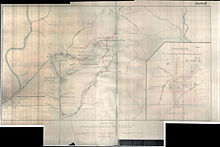Grünhirscher studs
| Grünhirscher studs | |||
|---|---|---|---|
| General information about the mine | |||
| Information about the mining company | |||
| Start of operation | 1691 | ||
| Funded raw materials | |||
| Degradation of | |||
| Geographical location | |||
| Coordinates | 51 ° 42 '20.4 " N , 10 ° 30' 12" E | ||
|
|||
| Location | Sankt Andreasberg | ||
| local community | Braunlage | ||
| District ( NUTS3 ) | Goslar | ||
| country | State of Lower Saxony | ||
| Country | Germany | ||
The Grünhirscher Stollen (also known as the Grünhirschler Stollen or Green Hirschler Stollen ) is a water solution gallery from the Upper Harz mining industry . The tunnel got its name from the Grüner Hirsch valley between the Galgenberg and the Glockenberg , where its mouth is located.
A 7.1 km long section of the 10.2 km long Green Hirscher tunnel in 2010 as part of the Upper Harz Water Regale for World Heritage of UNESCO appointed.
history
Work on the Grünhirscher tunnel began in 1691. Until 1710, the tunnel was only driven with mallets and irons to the Samson pit about 1.4 km away .
In the following years the tunnel was expanded and connected to other pits. So the studs 1729 was mine Wennsglückt durchschlägig . At that time, the greatest yields were achieved in 25 pits around Sankt Andreasberg. The main shaft of the Sankt Andreas and König Ludwig pits already had a depth of 400 m.
In order to be able to sink the pits further , a deeper water solution tunnel had to be created, as the Grünhirscher tunnel reached its limits. Therefore, the Sieberstollen was started, which is 58 meters lower and in 1754 "disinherited" the Grünhirscher Stollen. After the disinheritance, the water of the Grünhirscher Stollen, together with that of the Spötterstollen, was only used to drive synthetic bikes . In the pit of God's grace there was an artificial bike on the Grünhirscher tunnel.
At the beginning of the 19th century there were 26 field stretches in the pits Gnade Gottes and Samson under the Grünhirscher tunnel , each with 3 to 10 Lachter (5.7 to 19 meters) difference in height from one another. The route directly under the Grünhirscher tunnel was designated as the first route , the lower ones numbered in ascending order. In the Catharina Neufang mine, however, counting (1st section) began under the sieve tunnel. The 16th section (Samson pit) was the main waterway before the sieve tunnel was completed.
In 1922, the Grüner Hirsch power station was installed at a depth of 130 m in the Samson mine. It is one of two cavern power plants in the Samson mine that convert the hydropower from the Oder pond into electrical energy. The Grünhirscher tunnel guides the water into the Sperrlutter .
Location to other pits and tunnels
Deepening in penetrating pits
The Grünhirscher tunnel is penetrable in the following depths with the mentioned pits:
- Felicitas (approx. 33 laughs or 63 m)
- King Ludwig (50 laughs or 96 m)
- Sankt Andreas (55 Lachter or 106 m)
- Samson Pit (130 m)
- Catharina Neufang (84 laughs or 162 m)
Distance to other tunnels
- Spötter Stollen / St. Johannes Stollen (35 Lachter or 67 m higher)
- Edelleut Stollen (located 31 Lachter or 60 m higher)
- Fürsten Stollen (located 27 Lachter or 52 m higher)
literature
- Wilfried Ließmann : Historical mining in the Harz . 3. Edition. Springer, Berlin 2010, ISBN 978-3-540-31327-4 .
- Henning Calvör : Acta Historico-Chronologico-Mechanica circa metallurgiam in Hercynia superiori . Verlag der Fuerstl. Waysenhaus bookstore, Braunschweig 1763.
- Christian Keferstein (Hrsg.): Germany, geognostically and geologically represented and explained with charts and average drawings . tape 6 . Landes-Industrie-Comptoir, Weimar 1828.
- Archives for mineralogy, geognosy, mining and metallurgy . In: CJB Karsten, H. v. Dechen (Ed.): Issue 1 . 26th volume. Georg Reimer, Berlin 1854.
- CJB Karsten (Ed.): Archives for mining and metallurgy . 4th volume. Georg Reimer, 1821.
- Antoine-Marie Héron de Villefosse : About the mineral wealth . 2nd volume. Bernhard Friedrich Voigt , Sondershausen 1822.
See also
Web links
Individual evidence
- ↑ a b c Calvör: Acta Historico-Chronologico-Mechanica circa metallurgiam in Hercynia superiori. 1763, p. 34.
- ↑ Karsten, v. Dechen: Archives for Mineralogy, Geognosy, Mining and Metallurgy. 1854, p. 209.
- ↑ a b c Héron de Villefosse: About the mineral wealth. 1821, p. 269 f.
- ^ Ministry for Science and Culture of Lower Saxony: Upper Harz Water Management System. (PDF) 2008, p. 26 , accessed on December 2, 2015 (English).
- ↑ a b The Grünhirscher tunnel. Retrieved December 11, 2015 .
- ^ Ließmann: Historical mining in the Harz. 2010, p. 238 ff.
- ^ Karsten: Archives for mining and metallurgy. 1821, p. 310.
- ^ Keferstein: Teutschland, geognostically and geologically represented. 1828, p. 495.



